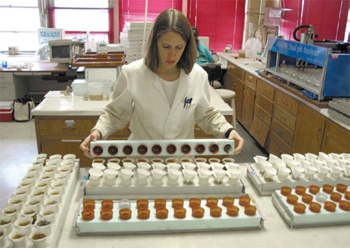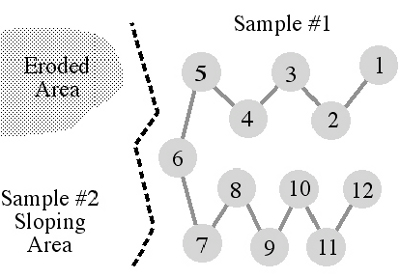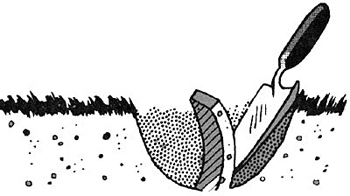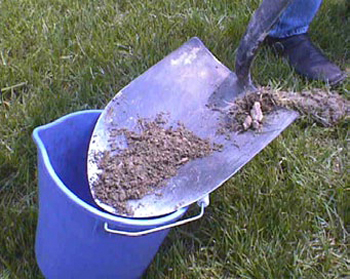
Soil testing labs
 Soil
tests are very helpful for any kind of serious gardener since they give
you solid, numerical data about your soil. You can think of them
as a report card, showing you positive (or negative) changes over the
years and also pointing out areas that you need to work on.
There's plenty of information out there (like this site) to tell you how to take the
actual soil test, and I recommend this in-depth
pdf document to learn more about how your test results relate to
individual crops.
But the real question is --- which laboratory should you send your soil
sample to?
Soil
tests are very helpful for any kind of serious gardener since they give
you solid, numerical data about your soil. You can think of them
as a report card, showing you positive (or negative) changes over the
years and also pointing out areas that you need to work on.
There's plenty of information out there (like this site) to tell you how to take the
actual soil test, and I recommend this in-depth
pdf document to learn more about how your test results relate to
individual crops.
But the real question is --- which laboratory should you send your soil
sample to?
I always recommend
starting by checking with your state extension
service since most offer free or cheap soil tests. However,
extension service laboratories often skimp on testing micronutrients
and heavy metals, so it's worth spending a bit more cash at least once
during the life of your garden to get an idea of the bigger picture.
 ATTRA
provides an extensive list of soil testing laboratories, but you could
spend hours checking out each one's services! (I know because I
just did.) When it comes to a wide selection of services for a
low price, there seem to be four main contenders.
ATTRA
provides an extensive list of soil testing laboratories, but you could
spend hours checking out each one's services! (I know because I
just did.) When it comes to a wide selection of services for a
low price, there seem to be four main contenders.
The cheapest
option is A&L Eastern Laboratories,
which offers a basic soil test for only $8.50 if you skip the
interpretation. (Since most interpretation is geared toward
large-scale farmers applying chemical fertilizers, you'll need to
figure out what the numbers mean on
your own anyway.) This test will cover organic matter, nitrogen,
phosphorus, potassium, magnesium, calcium, pH, buffer index, cation
exchange capacity, and percent base saturation. For an extra $4,
you can add on sulfur, zinc, manganese, copper, and boron. For
$15, you can test your soil for molybdenum, which is primarily of
interest for those of us trying to increase clover in our pastures.

AgriEnergy Resources offers pretty much the same tests
for quite a bit more cash.
Their basic package is $14.20 and throws in sodium (which you probably
don't need) while their higher end package includes the extras from the
last lab with the addition of iron for a total of $25. A separate
test for cobalt, molybdenum, and selenium is $46. Cobalt, like
molybdenum, is of interest to clover growers, while selenium is a
micronutrient important in our immune system but seldom deficient.
Maine Soil Testing Service is a little more expensive
than the cheapest commercial labs --- $15 for their basic test --- but includes
nearly all of the extras in the same package. However, they leave
out buffer index and percent base saturation while adding lead.
Finally, testing for nitrogen is $7 extra. (Although nitrogen is
very basic to the fertility of soil, I can see why they leave it out
--- you're going to add nitrogen in the form of compost every year
regardless and values can shift a lot from day to day depending on
microbial
activity. If you're not adding chemical fertilizers or farming on
a large scale, I'm not so sure you need to have that information in
your test results.)
 Finally, UMass Amherst has perhaps
the best deal of all, especially for urban dwellers
worried about heavy metals. Their base package ($10) has
everything previously mentioned except sodium, sulfur, organic matter,
and nitrogen (and molybdenum, cobalt, and selenium which aren't
available anywhere without paying quite a bit extra.) Meanwhile,
they add in four more metals --- cadmium, nickel,
aluminum, and chromium. I'd pay $15 for the basic tests plus
organic matter, though, because I think organic matter is important
enough to keep track of long term. Nitrogen is its own test,
available for $15, which I would skip, and I can do without sodium and
sulfur.
Finally, UMass Amherst has perhaps
the best deal of all, especially for urban dwellers
worried about heavy metals. Their base package ($10) has
everything previously mentioned except sodium, sulfur, organic matter,
and nitrogen (and molybdenum, cobalt, and selenium which aren't
available anywhere without paying quite a bit extra.) Meanwhile,
they add in four more metals --- cadmium, nickel,
aluminum, and chromium. I'd pay $15 for the basic tests plus
organic matter, though, because I think organic matter is important
enough to keep track of long term. Nitrogen is its own test,
available for $15, which I would skip, and I can do without sodium and
sulfur.
You'll hear the
results of my soil tests in a week or two, so stay tuned for more than
you ever wanted to know about interpreting soil test results. Why
not dig up your own soil sample and play along?
Want more in-depth information? Browse through our books.
Or explore more posts by date or by subject.
About us: Anna Hess and Mark Hamilton spent over a decade living self-sufficiently in the mountains of Virginia before moving north to start over from scratch in the foothills of Ohio. They've experimented with permaculture, no-till gardening, trailersteading, home-based microbusinesses and much more, writing about their adventures in both blogs and books.
Want to be notified when new comments are posted on this page? Click on the RSS button after you add a comment to subscribe to the comment feed, or simply check the box beside "email replies to me" while writing your comment.

I started my search online and found grow organic and doing a little research saw they used A&L. Researching a little more online (and due to our County Extension having some odd hours) I found an A&L branch in our town.
The grow organic website has a PDF for understanding the soil report. I found it through a google search:
http://www.lovesgardens.com/Attachments/SoilAnalysisBooklet1.pdf
It saved me a lot of time and helped me figure out the quantities for ammendments.
How often do you test your soil? We did it last year and did 3 different tests (3 parts of our small quarter acre yard; existing garden, and two future gardens.)
I was going to use A&L, but I liked the extra tests UMass offered. We don't test much, though, or I would go with the cheapest option. We tested our soil once (through the extension service) before we put in our first garden, but I've just about mined that data as far as it will go so, six years later, am testing again.
I figure the frequency of testing should depend on your needs. If your garden looks happy and is well established, you might get away with testing every 5 years or so, but in new areas (like our experimental chicken pastures), I'll probably test every year or two for a while to get a real handle on changes.
Thanks for the link to the pdf! That looks extremely helpful, and I'll enjoy comparing it with whatever UMass sends.
Dave --- I need to make some kind of link-back on posts like this, so that they list the later pages that link to them. The followup lunchtime series starts here (with later posts linked from the end of that post). There is also a slightly more polished/elongated version in Weekend Homesteader: January.